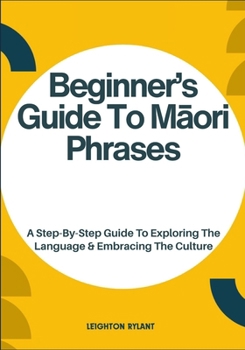Beginner's Guide To Māori Phrases: A Step-By-Step Guide To Exploring The Language & Embracing The Culture
The Māori people, the indigenous Polynesian inhabitants of New Zealand, speak Māori as their native language. It is one of the official languages of New Zealand, in addition to English and New Zealand Sign Language. Te reo Māori, or Māori, is a significant component of New Zealand's identity and has a complex cultural and historical significance.
Key Features of Māori Language:
- Phonetics: Māori has a relatively simple phonetic system compared to many European languages. It contains 15 letters in total-five vowels (a, e, i, o, u) and ten consonants (h, k, m, n, ng, p, r, s, t, w).
- Vowel Sounds: Vowels are crucial in Māori because each one can have a short or long sound, which can change the meaning of words. Long vowels are represented with a macron (ā, ē, ī, ō, ū).
- Pronunciation: Māori pronunciation is fairly straightforward once you get the hang of it, as the language is phonetic. For example, wh is pronounced like an English "f" (e.g., whānau = "family").
- Word Structure: Māori is an agglutinative language, meaning that it often uses prefixes and suffixes to modify the meaning of words. This structure can make sentences look a bit longer than their English counterparts.
- Articles: Māori has a system of definite and indefinite articles, similar to "the" and "a" in English: Te (the) for singular, definite nounsHe (a) for singular, indefinite nounsNgā (the) for plural, definite nouns- Sentence Structure: The typical sentence order in Māori is VSO (Verb-Subject-Object). This is different from English, which generally follows a Subject-Verb-Object (SVO) order. For example, "I eat an apple" in Māori would be "Ka kai au i te āporo."
- Cultural Context: Māori is deeply intertwined with the culture, traditions, and worldview of the Māori people. Many Māori words, phrases, and concepts cannot be fully understood outside of this context. This makes learning the language not just about the words themselves but also about the culture behind them.
Examples of Basic Phrases in Māori: Haere mai - Welcome Tēnā koe - Hello (to one person)Kei te pēhea koe? - How are you?Ngā mihi - Thank youAroha mai - SorryE noho rā - Goodbye (when someone is leaving)Haere rā - Goodbye (when you are leaving)Language Revival Efforts:
While Māori was once on the brink of extinction, there has been a concerted effort since the 1980s to revitalize the language. These efforts include the establishment of Māori language schools, immersion programs (Kura Kaupapa Māori), and the use of Māori in media, such as television and radio. The Māori Language Commission, established in 1987, works to promote and protect the language.
Māori is a language of "whakapapa" (genealogy). The Māori language places a strong emphasis on family connections, ancestry, and the relationship between people and the land, sea, and sky.
Key Features of Māori Language:
- Phonetics: Māori has a relatively simple phonetic system compared to many European languages. It contains 15 letters in total-five vowels (a, e, i, o, u) and ten consonants (h, k, m, n, ng, p, r, s, t, w).
- Vowel Sounds: Vowels are crucial in Māori because each one can have a short or long sound, which can change the meaning of words. Long vowels are represented with a macron (ā, ē, ī, ō, ū).
- Pronunciation: Māori pronunciation is fairly straightforward once you get the hang of it, as the language is phonetic. For example, wh is pronounced like an English "f" (e.g., whānau = "family").
- Word Structure: Māori is an agglutinative language, meaning that it often uses prefixes and suffixes to modify the meaning of words. This structure can make sentences look a bit longer than their English counterparts.
- Articles: Māori has a system of definite and indefinite articles, similar to "the" and "a" in English: Te (the) for singular, definite nounsHe (a) for singular, indefinite nounsNgā (the) for plural, definite nouns- Sentence Structure: The typical sentence order in Māori is VSO (Verb-Subject-Object). This is different from English, which generally follows a Subject-Verb-Object (SVO) order. For example, "I eat an apple" in Māori would be "Ka kai au i te āporo."
- Cultural Context: Māori is deeply intertwined with the culture, traditions, and worldview of the Māori people. Many Māori words, phrases, and concepts cannot be fully understood outside of this context. This makes learning the language not just about the words themselves but also about the culture behind them.
Examples of Basic Phrases in Māori: Haere mai - Welcome Tēnā koe - Hello (to one person)Kei te pēhea koe? - How are you?Ngā mihi - Thank youAroha mai - SorryE noho rā - Goodbye (when someone is leaving)Haere rā - Goodbye (when you are leaving)Language Revival Efforts:
While Māori was once on the brink of extinction, there has been a concerted effort since the 1980s to revitalize the language. These efforts include the establishment of Māori language schools, immersion programs (Kura Kaupapa Māori), and the use of Māori in media, such as television and radio. The Māori Language Commission, established in 1987, works to promote and protect the language.
Māori is a language of "whakapapa" (genealogy). The Māori language places a strong emphasis on family connections, ancestry, and the relationship between people and the land, sea, and sky.
Format:Paperback
Language:English
ISBN:B0FLWFW5V9
ISBN13:9798297261020
Release Date:August 2025
Publisher:Independently Published
Length:80 Pages
Weight:0.34 lbs.
Dimensions:0.2" x 7.0" x 10.0"
Related Subjects
HistoryCustomer Reviews
0 rating





